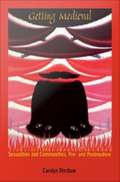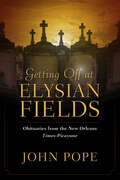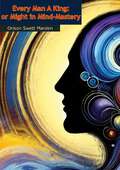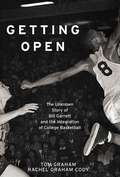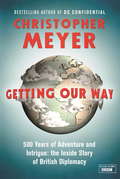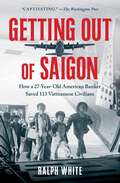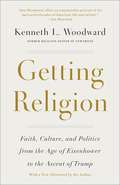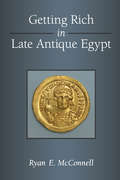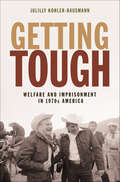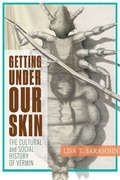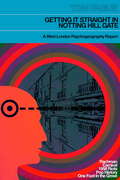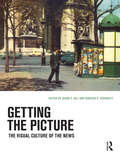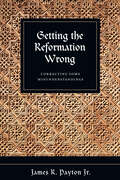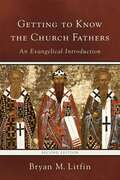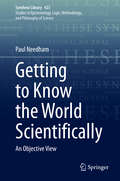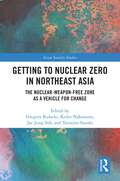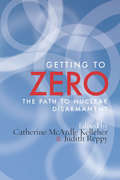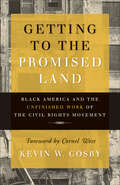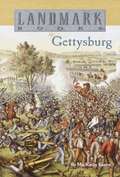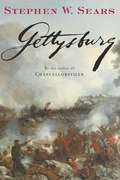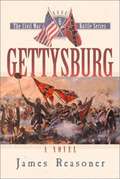- Table View
- List View
Getting Medieval: Sexualities and Communities, Pre- and Postmodern
by Carolyn DinshawIn Getting Medieval Carolyn Dinshaw examines communities--dissident and orthodox--in late-fourteenth and early-fifteenth-century England to create a new sense of queer history. Reaching beyond both medieval and queer studies, Dinshaw demonstrates in this challenging work how intellectual inquiry into pre-modern societies can contribute invaluably to current issues in cultural studies. In the process, she makes important connections between past and present cultures that until now have not been realized. In her pursuit of historical analyses that embrace the heterogeneity and indeterminacy of sex and sexuality, Dinshaw examines canonical Middle English texts such as the Canterbury Tales and The Book of Margery Kempe. She examines polemics around the religious dissidents known as the Lollards as well as accounts of prostitutes in London to address questions of how particular sexual practices and identifications were normalized while others were proscribed. By exploring contemporary (mis)appropriations of medieval tropes in texts ranging from Quentin Tarantino's Pulp Fiction to recent Congressional debates on U. S. cultural production, Dinshaw demonstrates how such modern media can serve to reinforce constrictive heteronormative values and deny the multifarious nature of history. Finally, she works with and against the theories of Michel Foucault, Homi K. Bhabha, Roland Barthes, and John Boswell to show how deconstructionist impulses as well as historical perspectives can further an understanding of community in both pre- and postmodern societies. This long-anticipated volume will be indispensible to medieval and queer scholars and will be welcomed by a larger cultural studies audience.
Getting Off at Elysian Fields: Obituaries from the New Orleans Times-Picayune
by John PopeNo city in America knows how to mark death with more funerary panache than New Orleans. The pageants commemorating departed citizens are often in themselves works of performance art. A grand obituary remains key to this Stygian passage. And no one writes them like New Orleanian John Pope. Collected here are not just simple, mindless recitations of schools and workplaces, marriages, and mourners bereft. These pieces in Getting Off at Elysian Fields: Obituaries from the New Orleans “Times-Picayune” are full-blooded life stories with accounts of great achievements, dubious dabblings, unavoidable foibles, relationships gone sour, and happenstances that turn out to be life-changing. To be sure, there are stories about Carnival monarchs, great philanthropists, and a few politicians. But because New Orleans embraces eccentric behavior, there are stories of people who colored way outside the lines. For instance, there was the doctor who used his plasma to make his flowers grow, and the philanthropist who took money she had put aside for a fur coat to underwrite the lawsuit that desegregated Tulane University. A letter carrier everyone loved turned out to have been a spy during World War II, and a fledgling lawyer changed his lifelong thoughts about race when he saw blind people going into a Christmas party through separate doors—one for white people and another for African Americans. Then there was the punctilious judge who got down on his hands and knees to edge his lawn—with scissors. Because New Orleans funerals are distinctive, the author includes accounts of four that he covered, complete with soulful singing and even some dancing. As a popular, local bumper sticker indisputably declares, “New Orleans—We Put the Fun in Funeral.”
Getting On
by Orison Swett MardenGetting On by Orison Swett Marden is an inspiring and practical guide to personal progress and success, offering timeless principles for achieving fulfillment in both career and life. As one of the foremost figures in the field of personal development, Marden encourages readers to cultivate essential habits like perseverance, ambition, and self-discipline to overcome obstacles and steadily advance toward their goals.Through engaging stories, practical advice, and motivational insights, Marden addresses the challenges that often stand in the way of progress, such as fear of failure, procrastination, and a lack of confidence. He emphasizes the importance of maintaining a positive mindset and taking consistent action, reminding readers that success is achieved not through luck but through persistence, hard work, and character development.Marden also discusses how to make the most of opportunities, cultivate resilience in the face of setbacks, and embrace continuous self-improvement. He underscores the value of building strong personal qualities—such as integrity, responsibility, and enthusiasm—as cornerstones for long-term success. His philosophy of “getting on” reflects the idea that life is a journey of continuous growth, where small, consistent efforts lead to meaningful achievements over time.Getting On encourages readers to take ownership of their personal development, no matter where they are starting from, and equips them with the tools to move forward with purpose and confidence. Marden’s practical approach makes the book an ideal resource for anyone looking to improve their career, relationships, or personal well-being.This timeless work continues to resonate with readers who seek motivation and direction, offering valuable insights into the principles of self-reliance and steady progress. Getting On remains a classic in the self-help genre, reminding us that success is within reach for those willing to take deliberate steps forward, no matter the challenges they face.
Getting Open
by Tom Graham Rachel Graham CodyBill Garrett was the Jackie Robinson of college basketball. In 1947, the same year Robinson broke the color line in major league baseball, Garrett integrated big-time college basketball. By joining the basketball program at Indiana University, he broke the gentleman's agreement that had barred black players from the Big Ten, college basketball's most important conference. While enduring taunts from opponents and pervasive segregation at home and on the road, Garrett became the best player Indiana had ever had, an all-American, and, in 1951, the third African American drafted in the NBA. In basketball, as Indiana went so went the country. Within a year of his graduation from IU, there were six African American basketball players on Big Ten teams. Soon tens, then hundreds, and finally thousands walked through the door Garrett opened to create modern college and professional basketball. Unlike Robinson, however, Garrett is unknown today. Getting Open is more than "just" a basketball book. In the years immediately following World War II, sports were at the heart of America's common culture. And in the fledgling civil rights efforts of African Americans across the country, which would coalesce two decades later into the Movement, the playing field was where progress occurred publicly and symbolically. Indiana was an unlikely place for a civil rights breakthrough. It was stone-cold isolationist, widely segregated, and hostile to change. But in the late 1940s, Indiana had a leader of the largest black YMCA in the world, who viewed sports as a wedge for broader integration; a visionary university president, who believed his institution belonged to all citizens of the state; a passion for high school and college basketball; and a teenager who was, as nearly as any civil rights pioneer has ever been, the perfect person for his time and role. This is the story of how they came together to move the country toward getting open. Father-daughter authors Tom Graham and Rachel Graham Cody spent seven years reconstructing a full portrait of how these elements came together; interviewing Garrett's family, friends, teammates, and coaches, and digging through archives and dusty closets to tell this compelling, long-forgotten story.
Getting Our Way: 500 Years of Adventure and Intrigue: the Inside Story of British Diplomacy
by Christopher MeyerOver the last five hundred years, Britain's power has waxed and waned: from the puny island nation of the sixteenth century, to the global superpower of the nineteenth century, to the more modest post-imperial status today of a major European power. But in these radically different circumstances, the wisdom of Lord Palmerston's observation has endured.Getting Our Way recounts nine stories from Britain's diplomatic annals over the last five hundred years, in which the diplomats themselves are at the centre of the narrative. It is an inside account of their extraordinary experiences, sometimes in the face of physical danger, often at history's hinge. Be it Henry Killigrew's mission to Edinburgh in 1572, Castlereagh at the Congress of Vienna, Our Man in Washington and the Nassau Deal, or the handover of Hong Kong to China, we can see how Britain has viewed its interests in the world and sought to advance them.Some of these dramatic episodes record triumph, some failure, but all of them illustrate how the three pillars of the national interest - security, prosperity and values - have been the foundation of British foreign policy for half a century. Each story is illuminated by colourful anecdotes and insights drawn from Christopher Meyer's first-hand experience of international relations.Moreover, the book is a salutary reminder that foreign policy (what is to be done) and diplomacy (how it is to be done) begin and end with the national interest. And far from being the preserve of aloof aristocrats, the pursuit of our national interest is replete with intrigue, treachery, espionage, and danger - an extraordinary combination of high principle and low cunning, vice and virtue, all with the specific aim of 'getting our way'.
Getting Our Way: 500 Years of Adventure and Intrigue: the Inside Story of British Diplomacy
by Sir Christopher MeyerA highly informed insider's account of some of the 'honest men' as they sought, by fair means or foul, to get Britain its way in the world.GETTING OUR WAY recounts nine stories from Britain's diplomatic annals over the last five hundred years, in which the diplomats themselves are at the centre of the narrative. It is an inside account of their extraordinary experiences, sometimes in the face of physical danger, often at history's hinge. Be it Henry Killigrew's mission to Edinburgh in 1572, Castlereagh at the Congress of Vienna, Our Man in Washington and the Nassau Deal, or the handover of Hong Kong to China, we can see how Britain has viewed its interests in the world and sought to advance them. Some of these dramatic episodes record triumph, some failure, but all of them illustrate how the three pillars of the national interest - security, prosperity and values - have been the foundation of British foreign policy for half a century. Each story is illuminated by colourful anecdotes and insights drawn from Christopher Meyer's first-hand experience of international relations. Moreover, the book is a salutary reminder that foreign policy and diplomacy begin and end with the national interest. And far from being the preserve of aloof aristocrats, the pursuit of our national interest is replete with an extraordinary combination of high principle and low cunning, vice and virtue, all with the specific aim of 'getting our way'.
Getting Out
by Nicolaus Mills Michael WalzerEventually every conqueror, every imperial power, every occupying army gets out. Why do they decide to leave? And how do political and military leaders manage withdrawal? Do they take with them those who might be at risk if left behind? What are the immediate consequences of departure? For Michael Walzer and Nicolaus Mills, now is the time to ask those questions about exiting--and to worry specifically about the difficulties certain to arise as we leave--Iraq.Getting Out approaches these issues in two sections. The first, entitled "Lessons Learned," examines seven historical cases of how and how not to withdraw: Britain's departure from the American colonies and from India, the French withdrawal from Algeria, Israel's unilateral withdrawal from Gaza, and the U.S. decision to leave (or not leave) the Philippines, Korea, and Vietnam. These cases offer a comparative perspective and an opportunity to learn from the history of political and military retreats.The second section, "Exiting Iraq," begins with an introduction to just how the United States got into Iraq and continues with an examination of how the U.S. might leave from a diversity of voices, ranging from those who believe that the Iraq war has produced no real good to those who hope for a decent ending. In addition to essays by volume editors Walzer and Mills, Getting Out features contributions by Shlomo Avineri, Rajeev Bhargava, David Bromwich, Frances FitzGerald, Stanley Karnow, Brendan O'Leary, George Packer, Todd Shepard, Fred Smoler, and Stanley Weintraub.
Getting Out of Saigon: How a 27-Year-Old Banker Saved 113 Vietnamese Civilians
by Ralph WhiteA &“captivating&” (The Washington Post) true story of &“courage, resolve, and determination&” (The Christian Science Monitor), author Ralph White&’s successful effort to save nearly the entire staff of the Saigon branch of Chase Manhattan bank and their families before the city fell to the North Vietnamese Army. In April 1975, Ralph White was asked by his boss to transfer from the Bangkok branch of the Chase Manhattan Bank to the Saigon Branch. He was tasked with closing the branch if and when it appeared that Saigon would fall to the North Vietnamese army and ensure the safety of the senior Vietnamese employees. But when he arrived, he realized the situation in Saigon was far more perilous than he had imagined. The senior staff members there urged him to evacuate the entire staff of the branch and their families, which was far more than he was authorized to do. Quickly he realized that no one would be safe when the city fell, and it was no longer a question of whether to evacuate but how. Getting Out of Saigon is an &“edge-of-your-seat&” (Oprah Daily) story of a city on the eve of destruction and the colorful characters who respond differently to impending doom. It&’s a remarkable account of one man&’s quest to save innocent lives not because he was ordered but because it was the right thing to do.
Getting Religion: Faith, Culture, and Politics from the Age of Eisenhower to the Era of Obama
by Kenneth L. Woodward"In this thoughtful book, Ken Woodward offers us a memorable portrait of the past seven decades of American life and culture. From Reinhold Niebuhr to Billy Graham, from Abraham Heschel to the Dali Lama, from George W. Bush to Hillary Clinton, Woodward captures the personalities and charts the philosophical trends that have shaped the way we live now." -Jon Meacham, author of Destiny and PowerImpeccably researched, thought-challenging and leavened by wit, Getting Religion, the highly-anticipated new book from Kenneth L. Woodward, is ideal perfect for readers looking to understand how religion came to be a contentious element in 21st century public life. Here the award-winning author blends memoir (especially of the postwar era) with copious reporting and shrewd historical analysis to tell the story of how American religion, culture and politics influenced each other in the second half of the 20th century. There are few people writing today who could tell this important story with such authority and insight. A scholar as well as one of the nation's most respected journalists, Woodward served as Newsweek's religion editor for nearly forty years, reporting from five continents and contributing over 700 articles, including nearly 100 cover stories, on a wide range of social issues, ideas and movements. Beginning with a bold reassessment of the Fifties, Woodward's narrative weaves through Civil Rights era and the movements that followed in its wake: the anti-Vietnam movement; Liberation theology in Latin America; the rise of Evangelicalism and decline of mainline Protestantism; women's liberation and Bible; the turn to Asian spirituality; the transformation of the family and emergence of religious cults; and the embrace of righteous politics by both the Republican and Democratic Parties. Along the way, Woodward provides riveting portraits of many of the era's major figures: preachers like Billy Graham and Jerry Falwell; politicians Mario Cuomo and Hillary Clinton; movement leaders Daniel Berrigan, Abraham Joshua Heschel, and Richard John Neuhaus; influential thinkers ranging from Erik Erikson to Elizabeth Kubler-Ross; cult leaders like Dr. Sun Myung Moon and est impresario Werner Erhardt; feminist theologians Rosemary Reuther and Elizabeth Schussler-Fiorenza; plus the author's long time friend, the Dalai Lama. For readers interested in how religion, economics, family life and politics influence each other, Woodward introduces fresh a fresh vocabulary of terms such as "embedded religion," "movement religion" and "entrepreneurial religion" to illuminate the interweaving of the secular and sacred in American public life. This is one of those rare books that changes the way Americans think about belief, behavior and belonging.From the Hardcover edition.
Getting Rich in Late Antique Egypt
by Ryan McconnellPapyrologists and historians have taken a lively interest in the Apion family (fifth through seventh centuries), who rose from local prominence in rural Middle Egypt to become one of the wealthiest and most powerful families in the Eastern Roman Empire. The focus of most scholarly debate has been whether the Apion estate—and estates like it—aimed for a marketable surplus or for self-sufficiency. Getting Rich in Late Antique Egypt shifts the discussion to precisely how the Apions’ wealth was generated and what role their Egyptian estate played in that growth by engaging directly with broader questions of the relationship between public and private economic actors in Late Antiquity, rational management in ancient economies, the size of estates in Byzantine Egypt, and the role of rural estates in the Byzantine economy. Ryan E. McConnell connects the family’s rise in wealth and status to its role in tax collection on behalf of the Byzantine state, rather than a reliance on productive surpluses. Close analysis of low- and high-level accounts from the Apion estate, as well as documentation from comparable Roman and Byzantine Egyptian estates, corroborate this conclusion. Additionally, McConnell offers a third way into the ongoing debate over whether the Apions’ relationship with the state was antagonistic or cooperative, concluding that the relationship was that of parties in a negotiation, with each side seeking to maximize its own benefit. The application of modern economic concepts—as well as comparisons to the economies of Athens, Rome, Ptolemaic Egypt, and Early Modern France—further illuminate the structure and function of the estate in Late Antique Egypt. Getting Rich in Late Antique Egypt will be a valuable resource for philologists, archaeologists, papyrologists, and scholars of Late Antiquity. It will also interest scholars of agricultural, social, and economic history.
Getting Tough: Welfare and Imprisonment in 1970s America (Politics and Society in Modern America)
by Julilly Kohler-HausmannThe politics and policies that led to America's expansion of the penal system and reduction of welfare programsIn 1970s America, politicians began "getting tough" on drugs, crime, and welfare. These campaigns helped expand the nation's penal system, discredit welfare programs, and cast blame for the era's social upheaval on racialized deviants that the state was not accountable to serve or represent. Getting Tough sheds light on how this unprecedented growth of the penal system and the evisceration of the nation's welfare programs developed hand in hand. Julilly Kohler-Hausmann shows that these historical events were animated by struggles over how to interpret and respond to the inequality and disorder that crested during this period.When social movements and the slowing economy destabilized the U.S. welfare state, politicians reacted by repudiating the commitment to individual rehabilitation that had governed penal and social programs for decades. In its place, they championed strategies of punishment, surveillance, and containment. The architects of these tough strategies insisted they were necessary, given the failure of liberal social programs and the supposed pathological culture within poor African American and Latino communities. Kohler-Hausmann rejects this explanation and describes how the spectacle of enacting punitive policies convinced many Americans that social investment was counterproductive and the "underclass" could be managed only through coercion and force.Getting Tough illuminates this narrative through three legislative cases: New York's adoption of the 1973 Rockefeller drug laws, Illinois's and California's attempts to reform welfare through criminalization and work mandates, and California's passing of a 1976 sentencing law that abandoned rehabilitation as an aim of incarceration. Spanning diverse institutions and weaving together the perspectives of opponents, supporters, and targets of punitive policies, Getting Tough offers new interpretations of dramatic transformations in the modern American state.
Getting Under Our Skin: The Cultural and Social History of Vermin
by Lisa T. SarasohnHow vermin went from being part of everyone's life to a mark of disease, filth, and lower status.For most of our time on this planet, vermin were considered humanity's common inheritance. Fleas, lice, bedbugs, and rats were universal scourges, as pervasive as hunger or cold, at home in both palaces and hovels. But with the spread of microscopic close-ups of these creatures, the beginnings of sanitary standards, and the rising belief that cleanliness equaled class, vermin began to provide a way to scratch a different itch: the need to feel superior, and to justify the exploitation of those pronounced ethnically—and entomologically—inferior. In Getting Under Our Skin, Lisa T. Sarasohn tells the fascinating story of how vermin came to signify the individuals and classes that society impugns and ostracizes. How did these creatures go from annoyance to social stigma? And how did people thought verminous become considered almost a species of vermin themselves? Focusing on Great Britain and North America, Sarasohn explains how the label "vermin" makes dehumanization and violence possible. She describes how Cromwellians in Ireland and US cavalry on the American frontier both justified slaughter by warning "Nits grow into lice." Nazis not only labeled Jews as vermin, they used insecticides in the gas chambers to kill them during the Holocaust.Concentrating on the insects living in our bodies, clothes, and beds, Sarasohn also looks at rats and their social impact. Besides their powerful symbolic status in all cultures, rats' endurance challenges all human pretentions. From eighteenth-century London merchants anointing their carved bedsteads with roasted cat to repel bedbugs to modern-day hedge fund managers hoping neighbors won't notice exterminators in their penthouses, the studies in this book reveal that vermin continue to fuel our prejudices and threaten our status. Getting Under Our Skin will appeal to cultural historians, naturalists, and to anyone who has ever scratched—and then gazed in horror.
Getting it Straight in Notting Hill Gate: A West London Psychogeography Report
by Tom VagueFrom 43AD, and the building of the (no doubt very straight) Roman Great West Road to Silchester, to 2009, another bout of Carnival Riots and David Cameron getting his bike nicked outside Tescos on the Grove, (retrieved with the help of a friendly / non-class conscious Rasta), long time Portobello Road resident and local historian/psychogeographer Tom Vague takes us on a breathless romp through the peoples history of W10, taking in Roman Coffins on Ladbroke Grove and Civil War skirmishes in Holland Park, Russian occultists at 77 Elgin Crescent, Tory anarchist GK Chesterton and his Napoleon of Notting Hill, Thomas Hardy compering poetry nights at 84 Holland Park Avenue with Wyndham Lewis and Ezra Pound, the pre WW1 Vorticist art HQ on Campden Hill Road ,WW2 bombs on Ladbroke Grove, Halliday Christie moving to 10 Rillington Place, teenage teddy boys rampaging at the Prince of Wales Cinema on Harrow Road, Max Mosely painting fascist Union Movement graffiti around Notting Hill in 1956, Peter Rachman renting properties to the 'blacks and Irish' before ruthlessly exploiting them all and ratcheting up local tensions, the infamous race riots of 1959, future Home Secretary Alan Johnsons' original mod band the Area playing the Pavillion pub on North Pole Road in 1965, Pink Floyd at the Free School, All Saints Church, 1966, Performance, Powis Square 1969, Mick Farrens' proto-punk Deviants at 56 Chesterton Road in 1970, Strummer, Jones and Simenon's Clash on the Westway, in the Elgin, at the carnival riots....
Getting the Picture: The Visual Culture of the News
by Jason E. Hill; Vanessa R. SchwartzPowerful and often controversial, news pictures promise to make the world at once immediate and knowable. Yet while many great writers and thinkers have evaluated photographs of atrocity and crisis, few have sought to set these images in a broader context by defining the rich and diverse history of news pictures in their many forms. For the first time, this volume defines what counts as a news picture, how pictures are selected and distributed, where they are seen and how we critique and value them. Presenting the best new thinking on this fascinating topic, this book considers the news picture over time, from the dawn of the illustrated press in the nineteenth century, through photojournalism’s heyday and the rise of broadcast news and newsreels in the twentieth century and into today’s digital platforms. It examines the many kinds of images: sport, fashion, society, celebrity, war, catastrophe and exoticism; and many mediums, including photography, painting, wood engraving, film and video. Packed with the best research and full colour-illustrations throughout, this book will appeal to students and readers interested in how news and history are key sources of our rich visual culture.
Getting the Reformation Wrong: Correcting Some Misunderstandings
by James R. Payton Jr.Institutes of the Christian Religion.Getting the Reformation Wrong:places the Reformation in the context of medieval and Renaissance reform effortsanalyzes conflicts among the Reformerssola fidesola Scripturaexamines how the Anabaptist movement fits in with the magisterial Reformationcritiques the post-Reformational move to Protestant Scholasticismexplores how the fresh perspective on the Reformation could make a difference in today's churches
Getting to Know the Church Fathers: An Evangelical Introduction
by Bryan M. LitfinThis concise introduction to the church fathers connects evangelical students and readers to twelve key figures from the early church. Bryan Litfin engages readers with actual people, not just abstract doctrines or impersonal events, to help them understand the fathers as spiritual ancestors in the faith. <p><p>The first edition has been well received and widely used. This updated and revised edition adds chapters on Ephrem of Syria and Patrick of Ireland. The book requires no previous knowledge of the patristic period and includes original, easy-to-read translations that give a brief taste of each writer's thought.
Getting to Know the World Scientifically: An Objective View (Synthese Library #423)
by Paul NeedhamThis undergraduate textbook introduces some fundamental issues in philosophy of science for students of philosophy and science students. The book is divided into two parts. Part 1 deals with knowledge and values. Chap. 1 presents the classical conception of knowledge as initiated by the ancient Greeks and elaborated during the development of science, introducing the central concepts of truth, belief and justification. Aspects of the quest for objectivity are taken up in the following two chapters. Moral issues are broached in Chap. 4, which discusses some aspects of the use and abuse of science, taking up the responsibilities of scientists in properly conducting their business and decision-makers in their concerns with the import of science for society. Part 2 contrasts the view of scientific progress as the rejecting of old hypotheses and theories and replacing them with new ones, represented by Karl Popper, with the conception of progress as accumulating knowledge, saving as much as possible from older theories, represented by Pierre Duhem. A concluding chapter defends the natural attitude of taking the theories of modern science to be literally true, i.e. realism, in the face of arguments drawn partly from the history of scientific progress in criticism of this stance.
Getting to Nuclear Zero in Northeast Asia: The Nuclear-Weapon-Free Zone as a Vehicle for Change (Asian Security Studies)
by Jae-Jung Suh Keiko Nakamura Gregory Kulacki Tatsujiro SuzukiThis book presents realistic alternatives to security policies based on nuclear weapons for the Northeast Asian region.Northeast Asian governments and populations feel less secure than ever, and the governments of the USA, Russia, China, and North Korea are all expending considerable resources on increasing their nuclear arsenals. This book presents realistic alternatives to security policies dependent on threats to use nuclear weapons and demonstrations of the resolve to use them in a war. Those alternatives are grounded in the well-established concept of common security. The long-term goal of these alternatives is the establishment of a nuclear-weapon-free zone in Northeast Asia. This book demonstrates that lessons learned during the creation of existing nuclear-weapon-free zones can be successfully adapted, using the proposed alternatives to nuclear threats, to the considerably more challenging circumstances that exist in contemporary Northeast Asia. More importantly, it makes the case that the mere process of pursuing this objective, even if the goal is not realized for many decades, would help facilitate regional risk-reduction measures and global nuclear arms control measures that could lead, in the long term, to the general and complete disarmament promised by the Nuclear Nonproliferation Treaty (NPT) and the Treaty on the Prohibition of Nuclear Weapons (TPNW) of 2021. This book will be of interest to students of nuclear proliferation, Asian security, foreign policy, and International Relations.
Getting to Yes with China in Cyberspace
by Martin C. Libicki Scott Warren Harold Astrid Stuth CevallosThis study explores U.S. policy options for managing cyberspace relations with China via agreements and norms of behavior. It considers two questions: Can negotiations lead to meaningful agreement on norms? If so, what does each side need to be prepared to exchange in order to achieve an acceptable outcome? This analysis should interest those concerned with U.S.-China relations and with developing norms of conduct in cyberspace.
Getting to Zero
by Mcardle Kelleher Catherine Reppy JudithGetting to Zero takes on the much-debated goal of nuclear zero—exploring the serious policy questions raised by nuclear disarmament and suggesting practical steps for the nuclear weapon states to take to achieve it. It documents the successes and failures of six decades of attempts to control nuclear weapons proliferation and, within this context, asks the urgent questions that world leaders, politicians, NGOs, and scholars must address in the years ahead.
Getting to the Promised Land: Black America And The Unfinished Work Of The Civil Rights Movement
by Kevin W. Cosby<p>Too often, all oppressed people in America are lumped together under the moniker people of color, as if each group's experience under the yoke of systemic racism has the same economic and social repercussions. But the American Descendants of Slavery (ADOS) hold a unique claim to economic and reparative justice: for ADOS, after all, is the only group whose ancestors were forcibly brought to America, enslaved, built much of the wealth of the country, yet continue to be specifically excluded from the same social, political, and economic rights of other Americans. To that end, Rev. Dr. Kevin W. Cosby lays out the first theology of the ADOS movement, turning the traditional lens of Black liberation theology from Moses leading escaped Hebrew slaves in Exodus to other biblical leaders like Solomon, Daniel, and Nehemiah. A Jew born in exile, Nehemiah landed a somewhat privileged position in the Persian king's court. After learning about his people's dire situation in Jerusalem, Nehemiah wept and was moved to lead efforts to rebuild the wall around the city with money (reparations) obtained from the imperial government.</p><p>In the stories of Nehemiah and other biblical leaders, Cosby finds inspiration on how to rebuild Black America including the necessity of government reparations for ADOS. Cosby calls all Americans to move from a place of relative nonengagement and detachment to a place of active support of ADOS's efforts for justice and healing.</p>
Gettysburg
by John BrickTom and Will, Yankee soldiers, spend most of their convalescent leave on a rebel girl's Pennsylvania farm to help her out, instead of going on to Tom's home in New York. Both fall in love with her and plan to return to her after the war. Her brother, who is also a rebel, home from the war convalescing from a wound, turns them over to invading rebel troops when they come to the farm in order to convince them that he isn't a spy or a deserter. With some help, Will and Tom escape and are just in time for the battle of Gettysburg, which they would have missed had they only taken the last week of their leave. After fighting among The Devil's Rocks, one is killed and the other survives after spending two days lying seriously wounded on the battlefield. He writes to Susan, the rebel girl, but receives the letter back, so he begins a search for her.
Gettysburg
by Mackinlay KantorWhen troops entered Gettysburg, Pennsylvania, the South seemed to be winning the Civil War. But Gettysburg was a turning point. After three bloody days of fighting, the Union finally won the battle. Inspired by the valor of the many thousands of soldiers who died there, President Lincoln visited Gettysburg to give a brief but moving tribute. His Gettysburg Address is one of the most famous speeches in American history.
Gettysburg (Gettysburg Civil War Institute Bks.)
by Stephen W. SearsStephen W. Sears has delivered a masterwork in Gettysburg, his single-volume history of the Civil War's greatest campaign. Drawing on original source material, from soldiers' letters to the Official Records of the war, Sears offers dramatic and informed accounts of every aspect of the campaign, from well-hewn portraits of the battle's leaders to detailed analyses of their strategies and tactics. Sears depicts General Meade's remarkable performance in his first week of army command and pinpoints General Lee's responsibility in the agonizing failure of the Confederate army. With characteristic style and insight, Sears brings the epic tale of the battle in Pennsylvania vividly to life.
Gettysburg (The Civil War Battle Series, Book #6)
by James Reasoner[From the back cover] Lower down on the slope, the cannon fire was still crashing among the trees, so they couldn't retreat. Will's brain was growing battle-numbed, but he understood that much. He and his companions could go up to death or down to death, but either way, that was all that awaited them. A huge anger began to grow inside him. They had fought so hard, so well, for so long. They had won battles they weren't supposed to win, defeating enemy forces that were larger-sometimes more than twice as large-and better armed and equipped. They had dared to hope that the justness of their cause would carry them to victory against great odds. And for a time that victory had seemed to be within their grasp. Now...now it was slipping away. One more battle, the men had said on their way up here to Pennsylvania. One more fight, one more defeat for the Yankees, and they would give up. They would see they had been wrong. It was almost over, and when it was they could all go home... One more battle. It was no high-pitched, keening Rebel yell that came from Will's throat as he threw himself up the slope once more. Instead it was a hoarse, inarticulate shout of rage. The power of that shout reached out to the men around him and drew them with him, and together they went up the hill and over the crest. Bullets fanned the air around them, but they no longer cared. In their hearts burned the bitter blaze of men who knew they were about to die. A hundred yards away thousands of Yankees crouched behind breastworks that had been erected over the past two days. The volley of fire that roared from their rifles swept the rim of the hill. The leading edge of the Confederate advance was blasted back, but as each man fell another took his place...until finally there were no more ...
